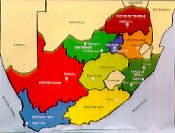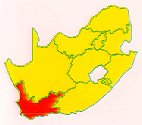

South Africa's people are indeed a rainbow nation. This nation is made up of a few remaining members of the San (Bushmen); of Nguni people, who constitute about two-thirds of the entire population and speak mainly isiXhosa, isiZulu, sisSwati and isiNdebele; the Sotho-Tswana people, who have among them South, North and West Sotho (Tswanas), each with their own language; the Tsonga; the Venda, coloureds, Indians; Afrikaners, English people, people who have immigrated from the Netherlands, France, Portugal, Italy and other European countries, and Chinese people.
The Republic of South Africa occupies the southernmost part of the African continent. It has common boundaries with Namibia, the Republic of Botswana and Zimbabwe, while the Republic of Mozambique and the Kingdom of Swaziland lie to the north-east. Completely enclosed by South African territory in the south-east, is the Kingdom of Lesotho.
To the west, south and east, South Africa borders on the South Atlantic and southern Indian oceans. Isolated, 1920 km south-east of Cape Town in the South Atlantic, lie Prince Edward and Marion islands taken into possession by South Africa in 1947. The lengthy coastline is swept by two major ocean currents - the warm, south-flowing Agulhas and the cold, north-flowing Benguela systems respectively.
The coastline itself is an even, closed one with few bays or indentations naturally suited for harbours. The only ideal natural harbour along some 3000 km of coastline, is Saldanha Bay in the south-west. Most South African river mouths are unsuitable for use as harbours because large sandbars block entry for large parts of the year.
The country falls squarely within the subtropical belt of high pressure, making it dry, but with an abundance of sunshine. The wide expanses of ocean on three sides of South Africa have a moderating influence on its climate. More apparent, however, are the effects of the warm Agulhas and cold Benguela currents along the east and west coasts respectively.
South Africa has an average annual rainfall of only 464 mm, against a world average of 857 mm. In total, 65 percent of the country has an annual rainfall of less than 500 mm - usually regarded as the absolute minimum for successful dryland farming.
South Africa's rainfall is unreliable. Large fluctuations in the average annual figure are the rule rather than the exception in most areas of the country. South Africa is also periodically afflicted by prolonged droughts which often end in severe floods.
South Africa is famous for its sunshine. Minimum hours of sunshine coincide with the rainy seasons. Generally speaking, April and May are usually the pleasant months. The rainy season over the summer rainfall region has then ended, while it has not yet really begun in the winter rainfall are. The hot summer weather has abated and the winds are lighter than during the rest of the year. Temperatures above 32 degrees Celsius are fairly common in summer.
In terms of the Constitution, 1993 (Act 200 of 1993), the Republic of South Africa is divided into nine provinces, each with its own legislature, premier and ministers.
The provinces are the Western Cape, Eastern Cape, Northern Cape,
Free State, KwaZulu-Natal, North-West, Gauteng, Mpumalanga and
the Northern Province.

Capital: Cape Town (also legislative capital of the country)
Other important towns: Vredenburg-Saldanha, Worcester, Stellenbosch, George, Oudtshoorn, Beaufort West
Principal languages: Afrikaans (62,2%), English (20%), isiXhosa (15,3%)
Population (27 April 1994): 3 633 077
% of total: 9%
Area (km2): 129 370
% of total: 10,6%
Farming: fruit, vegetables, viticulture, ostriches, wheat, sheep, race-horse breeding
Industries: fishing, gas and oil (Mossgass), textiles, printing and publishing, forestry
Capital: Bisho
Other important towns: Port Elizabeth, East London, Umtata, King William's Town, Grahamstown, Graaff-Reinet, Cradock, Stutterheim, Aliwal North, Port St. Johns
Principal languages: isiXhosa (82,6 %), Afrikaans (9,6%), English (4,2%)
Population (27 April 1994): 6 436 790
% of total: 16%
Area (km2): 169 600
% of total: 13,9%
Farming: deciduous fruit, sheep, angora, pineapple, chicory, dairy products, coffee, tea, cattle, maize and sorghum
Industries: motor-manufacturing, forestry
Capital: Kimberley
Other important towns: Upington, Springbok, Kuruman, De Aar, Sutherland, Colesbrg, Prieska, Carnavon, Kenhardt
Principal languages: Afrikaans (66%), Setswana (19%), isiXhosa (6,2%)
Population (27 April 1994): 737 306
% of total: 1,8%
Area (km2): 361 800
% of total : 29,7%
Farming: Karakul sheep, dried fruit, viticulture, wheat, peanuts, maize, cotton
Industries: mining (diamonds, iron ore, copper, asbestos, manganese, fluorspar, semi-precious stones, marble)
Capital: Bloemfontein
Other important towns: Welkom, Odendaalsrus, Kroonstad, Parys, Phuthaditjhaba, Bethlehem
Principal languages: Sesotho (57,4%), Afrikaans (14,7%), isiXhosa (9,4%)
Population: (27 April 1994): 2 726 840
% of total: 6,8%
Area (km2): 129 480
% of total: 10,6%
Farming: maize, sheep, cherries, dairy, soya, sorghum, sunflower, wheat, potatoes
Industries: mining (gold), petrol-from-coal
(The only province with a monarchy specifically provided for in the 1993 Constitution)
Capital: uncertainty exists as to whether the capital will be Pietermaritzburg or Ulundi
Other important towns: Durban, Richards Bay, Eshowe, Newcastle, Piet Retief, Escourt, Ladysmith, Richmond
Principal languages: isiZulu (79,3%), English (16%), Afrikaans (1,9%)
Population (27 April 1994): 8 505 338
% of total: 21,1%
Area (km2): 92 180
% of total: 7,6%
Farming: sugar, subtropical fruit, vegetable, dairy and stock-farming
Industries: coal-mining, forestry
Capital: Mmabatho
Other important towns: Klerksdorp, Orkney, Stilfontein, Potchefstroom, Mafikeng, Mankwe, Brits
Principal languages: Setswana (59%), isiXhosa (6,3%), Sesotho (5%)
Population (27 April 1994): 3 252 991
% of total: 9,5%
Farming: game, maize, sunflowers, cattle, tobacco, citrus, paprika, peppers, cotton
Industries: mining (uranium, diamonds, platinum, marble, fluorspar, gold), manufacturing, construction
Capital: Johannesburg
Other important towns: Pretoria (administrative capital of the country), Soweto, Krugersdorp, Roodepoort, Germiston, Springs, Boksburg, Benoni, Brakpan, Kempton Park, Cullinan, Vanderbijlpark, Vereeniging, Heidelberg, Nigel, Bronkhorstspruit
Principal languages: Afrikaans (20%), isiZulu (18,4%), English (16,1%)
Population (27 April 1994): 6 869 103
% of total: 17%
Area (km2): 18810
% of total: 1,6%
Farming: diary products, vegetables, fruit, flowers, maize, ground nuts, sunflowers, cotton, sorghum
Industries: mining (gold), manufacturing, finance, transport
Capital: Nelspruit
Other important towns: Witbank, Standerton, Piet Retief, Ermelo, Barberton, Sabie
Principal languages: siSwati (30,2%), isiZulu (24,2%), Afrikaans (9,3%)
Population (27 April 1994): 2 921 559
% of total: 7,3%
Area (km2): 78 370
% of total: 6,4%
Farming: dairy farming, citrus and tropical fruit, nuts, vegetables, sugar, wool, cotton, tobacco, wheat, potatoes, sunflower, maize
Industries: forestry, mining (gold, coal, steel, vanadium), paper mills
Capital: Pietersburg
Other important towns: Warmbaths, Nylstroom, Potgiestersrus, Pietersburg, Louis Trichardt, Messina, Thabazimbi, Tzaneen, Giyani, Seshego, Lebowakgomo, Thohoyandou
Principal languages: Sepedi (56,7%), Xitsonga (22,7%)
Population (27 April 1994): 5 201 630
% of total: 12,9%
Area (km2): 123 280
% of total: 10,1%
Farming: cattle, game, table grapes, tea, coffee, tropical fruit, sunflowers, cotton, maize, peanuts
Industries: mining (iron, copper, asbestos, coal, platinum), forestry
GGP (1991): R10 529 million.
*All statistics in this chapter were derived from RSA Statistics
in Brief 1994 (Central Statistical Service).

 go back
go back